How To Do Everything in Golf
Golf Digest Gave Us This Complete Guide to Making The Game Less Confusing & More Fun
Golf Digest is a great resource in the world of golf. Visit their Website to see what else they provide that can help you to play better and enjoy the game more, and/or click the magazine above to get a monthly subscription delivered to your home or office.
Big thanks to them for providing this comprehensive, yet simple guide to understanding How to Do Everything in Golf.
Now let's learn How to Do Everything in Golf
Make use of the TOC below to find what you need to know. There is a link after every section to bring you right back to the TOC
Do Everything Table of Contents
- How to Mark Your Ball
- How to Rake a Bunker
- How to Tend The Flagstick
- How to Read a Green
- How to Repair a Ball Mark
- How to Take Relief
- How to Play "Ready Golf"
- How to Let People Play Through
- How to Be a Good Guest
- How to Not Be An Annoying Partner
- How to Check Your Phone While Playing
- How to Play With Your Spouse
- How to Play With a Beginner
- How to Find The Right Pro For You
- How to Get The Most Out Of a Lesson
- How to Maximize Your Range Time
- How to Practice vs. Warm Up
- How to Improve in Your Backyard
- How to Buy The Right Clubs For You
- How to Pack Your Golf Bag
- How to Keep Your Clubs in Good Condition
- How to Ship Your Clubs
- How to Handle First-Tee Jitters
- How to Holler "Fore!"
- How to Survive a Nightmare Round
- How to Not Lose a Ball
- How to Play in Foul Weather
- How to Stretch
- How to Get Exercise When Driving a Golf Cart
- How to Eat and Drink During a Round
- How to Play in Heat and Humidity
- How to Dress for The Course
- How to Pack For a Golf Trip
- How to Tip
- How to Pick a Buddies Trip Destination
- How to Take a Golf Photo
- How to Join a Club
- How to Pick a Partner For a Team Event
- How to Play a Nassau
- How to Get The Most From a Caddie
- How to Get a Handicap
- How to Use a Handicap in a Match
On-Course Basics
How to Mark Your Ball
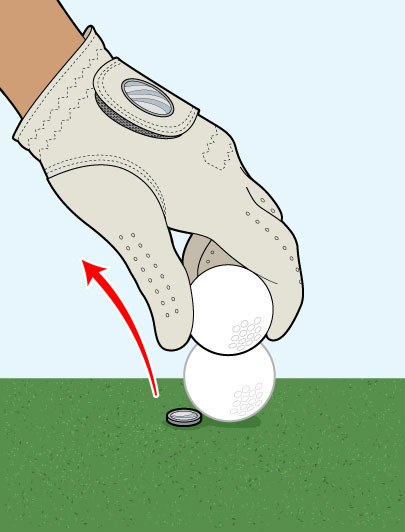 How to Mark Your Ball
How to Mark Your BallWhen you are on the green, you should mark your golf ball with a small coin or ball marker. Place the mark just behind your ball before picking up the ball. When it is your turn to putt, place the ball on the green in its original location before picking up the mark. If your mark is possibly in the way of a playing partner's putting line, ask if they want you to move it. If so, pick a tree or another standstill object to line your ball mark up with and move it a putter head or two to the right or left. Remember to return your ball to its original spot — not where you moved your mark — before putting.
Return to the Do Everything in Golf Table of Contents
How to Rake a Bunker
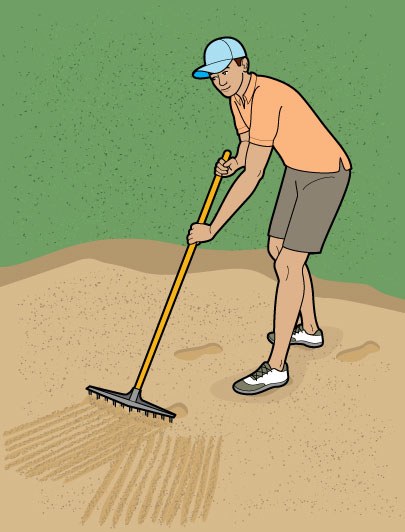 How to Rake a Bunker
How to Rake a BunkerAfter hitting a shot from a bunker, you are obligated to leave the sandy hazard in good shape. That means raking the area you hit, where you stood, where you walked, and even cleaning up the mess made by someone else. Rake the sand toward you as you walk backward to exit the bunker. When you are done, leave the rake just outside of the bunker, unless the rake has a message on it that says to leave it inside.
Return to the Do Everything in Golf Table of Contents
How to Tend a Flag Stick
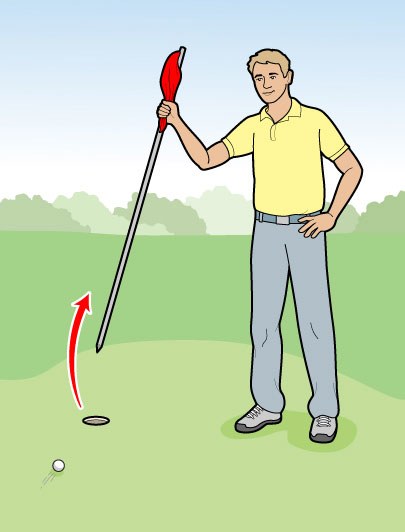 How to Tend a Flag Stick
How to Tend a Flag StickWhen everyone in your group is on the green, it's the person whose ball is closest to the hole's responsibility to handle the flagstick. Ask the golfer whose ball is farthest away whether or not they want the flag tended. If they decline, pull the flag and lay it down on the green somewhere out of the way. If they want you to tend, stand to the side of the hole and hold the flagstick with your hand over the flag to prevent it from flapping. Dislodge it from the bottom of the cup, but hold it so that it still rests in the hole as your playing partner putts. Pull the flagstick completely out if the ball is heading toward it so that your playing partner doesn't receive a two-stroke penalty for hitting it with his ball.
* Note - The Rules of Golf now allow the flagstick to remain in the hole while putting!
Return to the Do Everything in Golf Table of Contents
How to Read a Green
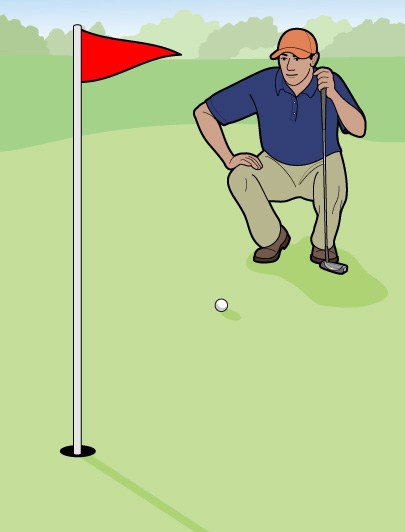 How to Read a Green
How to Read a GreenThe key to reading putts is to establish a routine. Begin as you approach the green, observing the overall slopes and undulations. Then without distracting your playing companions, read your putt while others putt out. This helps speed play. As you study your putt, look first from behind the ball and then from the low side of the putt (the side the ball will break toward). Try to get a sense of how fast the green is. Generally, the faster the green the more the putt will break. The slight exception to this rule is on Bermuda grass, which is very grainy, meaning that the direction the grass grows affects the putt. One final thought about reading greens: The harder you hit a putt, the less the break becomes a factor.
Return to the Do Everything in Golf Table of Contents
How to Repair A Ball Mark
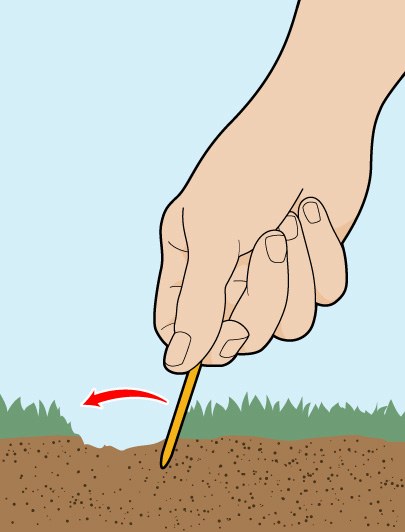 How to Repair A Ball Mark
How to Repair A Ball MarkWhen a ball lands on a green it leaves an indentation. These are easy to repair, and will do no damage to the green if fixed right away. Stick a divot repair tool or a tee into the turf around the outside of the mark. Gently lift the compacted soil to loosen and raise it and move around the entire ball mark in a circle. Once you've done this, take your putter and softly tap down the turf so it is level with the rest of the green. The rules of golf allow you to repair ball marks that are on your line. You are not allowed to repair spike marks, but it is a good idea to repair any pitch marks or spike marks you see before leaving the green — as long as you don't hold up play.
Return to the Do Everything in Golf Table of Contents
How to Take Relief
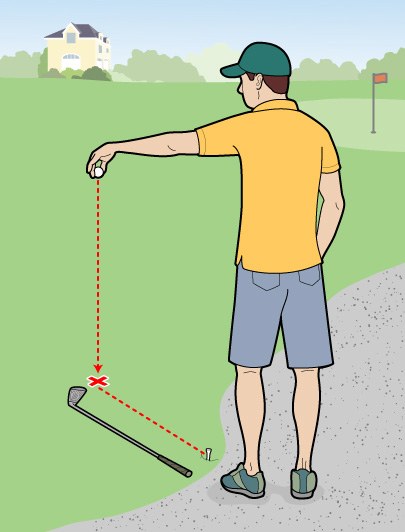 How to Take Relief
How to Take ReliefThe Rules of Golf allow a player to take relief without penalty from cart paths, ground under repair and casual water. Anytime the lie of a player's ball, his stance, or the area of his intended swing are affected by one of these situations, the player is entitled to lift and clean his ball, then drop it within one club-length of the spot where the player would have complete relief. To summarize the actual routine for taking relief: (1) take your stance, avoiding the interference, no nearer the hole; (2) determine where your club head would lie, given this stance, and if you like, mark this point with a tee; (3) drop at this point or within one club-length of it, no nearer the hole.
— Tom Meeks, former USGA senior director of rules and competition
* Note - The Rules of Golf now require that all drops be taken from knee-height!
Return to the Do Everything in Golf Table of Contents
Etiquette
How to Play Ready Golf
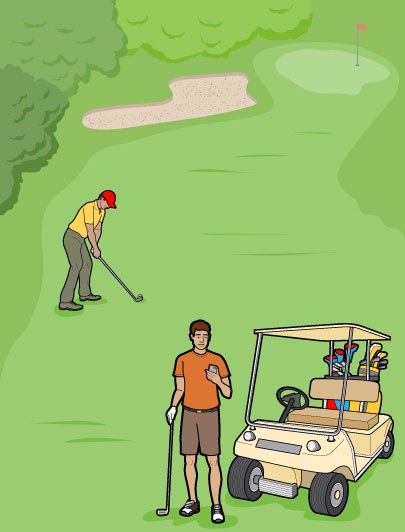 How to Play Ready Golf
How to Play Ready GolfIt's quite a simple concept: golfers should play in the order they are ready, not necessarily in the order deemed by the rules of golf. For casual rounds, don't worry about who is away from the hole or who has the honor on the next tee. If you are ready, and you aren't in anyone's way, alert your group you are playing your next shot and hit it. Of course, this less formal style should be established with your playing partners before or early in your round. Provided everyone keeps an eye on what everyone else in the group is doing, it's the kind of request that isn't likely to be denied.
Return to the Do Everything in Golf Table of Contents
How to Let People Play Through
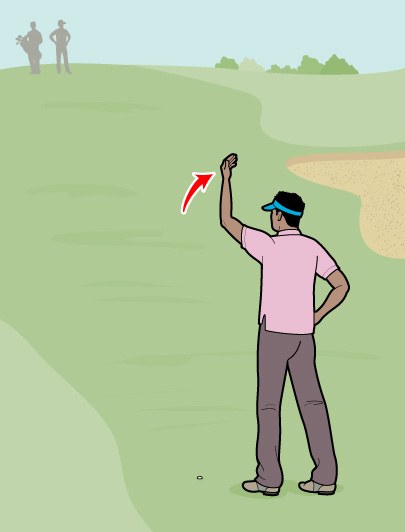 How to Let People Play Through
How to Let People Play ThroughIf you find that you are holding up play, or that there is a hole or more open ahead of you, the polite thing to do is let the group immediately behind you play through -- or skip ahead -- of your group. The best place to do this is a par 3. After marking your ball, motion to the group on the tee to hit their tee shots. While the group approaches the green, go ahead and putt out, or, if you like, simply wait for them to putt out, before finishing that hole. There is no law against letting the group through on any other hole, however, even after you've begun playing it. This takes very little time, helps speed up play, and keeps everyone happy.
Return to the Do Everything in Golf Table of Contents
How to Be a Good Guest
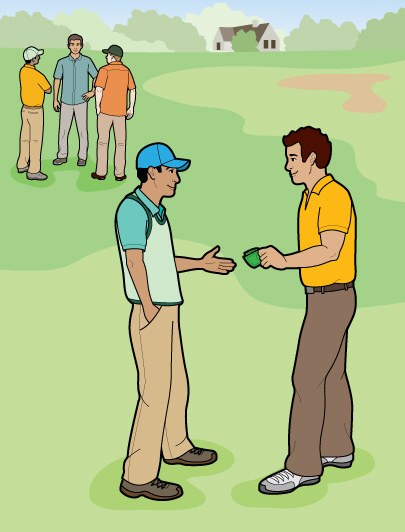 How to Be a Good Guest
How to Be a Good GuestThe biggest thing to remember is that your behavior reflects not only on you but on your host. Arrive with plenty of time to warm up, and agree ahead of time on where to meet your partner. Without making a federal case out of it, offer to pay for snacks at the halfway house and for every other round in the clubhouse following the match. It's also a nice gesture to volunteer to pay the caddie fees, and to tip the locker-room attendant. On the course, be generous with your compliments concerning both good shots and the course itself, and never lose your temper. Common sense is your best guide. Act the way you'd like a guest to act at your course — and make a point of inviting your host to play as your guest within the year.
Return to the Do Everything in Golf Table of Contents
How to Not Be An Annoying Partner
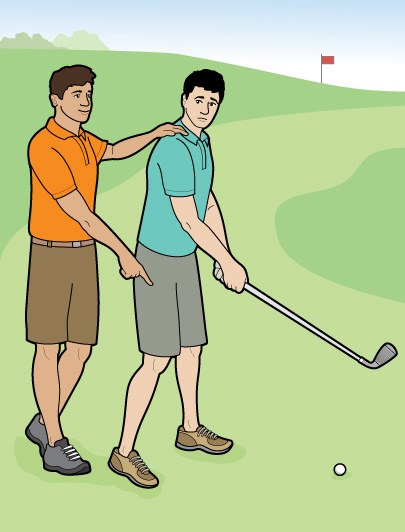 How to Not Be An Annoying Partner
How to Not Be An Annoying PartnerThe first step is to brim with positivity, always. Praise your pal's good shots and ignore or console the bad. Rebukes such as "what's got into you today?" never work. On the playing end, don't give lessons, read his putts, advise on club selection or blurt which way the wind is blowing, unless he asks. Don't point out obvious hazards. Don't whine about your own bad shots. Be careful about praising his shot while in mid-air; if it takes a bad bounce into a bunker, he'll rightfully give you the evil eye. On the interpersonal end, don't complain about the course. Don't put your sandwich on his cart seat. Always drive to the shortest ball first. Don't stomp on the brake or accelerate suddenly. That's a lot of don'ts, but they seem to matter more than the do's.
Return to the Do Everything in Golf Table of Contents
How to Check Your Phone While Playing
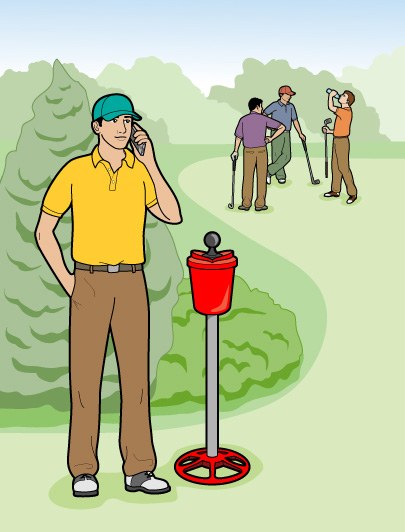 How to Check Your Phone While Playing
How to Check Your Phone While PlayingWe know, we know — you're VERY important. But unless you're authorizing military force somewhere, we'd like to think you can afford to have your phone out of reach for more than two minutes at a time. It's not that we're opposed to phones on the golf course, especially if they're enabling you to sneak away from the office. But common courtesy still applies. If you need to return an email, do so in between holes where you're not holding up play. If a phone call is essential, bow out to a place where you can't be heard by other golfers. And if a phone call is NOT essential, save it for later. Golf should be a time to connect with your playing partners, with the outdoors, and with yourself. The rest of the world can surely manage without you for a few more hours.
Return to the Do Everything in Golf Table of Contents
How to Play With Your Spouse
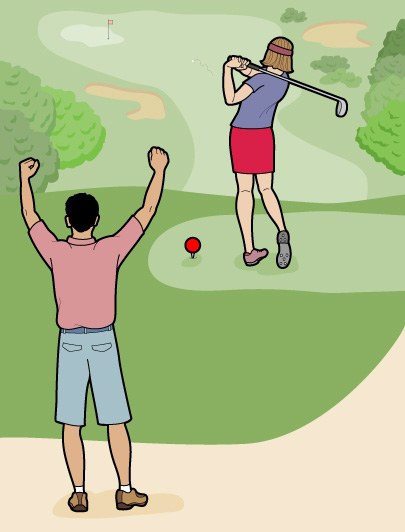 How to Play With Your Spouse
How to Play With Your SpouseLet's not make this harder than it is. Adopt the seven habits of Cordial Spousal Golf. 1) Expect nothing. 2) Stop teaching! And don't ask for advice. 3) Be complimentary. "That's a peach, hon," is your fallback. 4) If it's a competition, decide if you and your spouse can agree on an equal level of intensity. 5) Stop when he or she wants to stop. Four holes? Nine holes? Fine. Right before that dumb little hole over the ugly pond? Absolutely. 6) If you play with another couple, genders ride together. That way there's always a guy around to remind the other guy not to drive past the red tees. 7) Congratulate yourself for doing a good thing. Sharing the game you (usually) love with the one you (usually) love is almost always good for the game, and may be good for your game.
Return to the Do Everything in Golf Table of Contents
How to Play With a Beginner
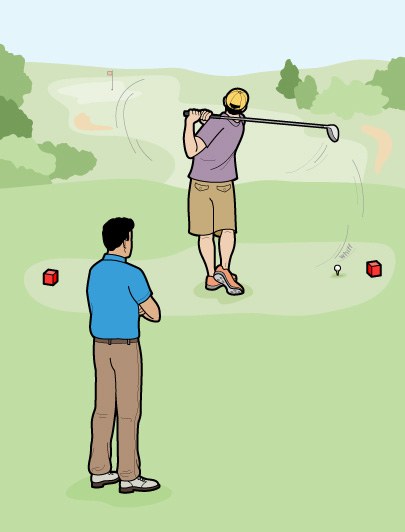 How to Play With a Beginner
How to Play With a BeginnerLow-handicappers sometimes look down on playing with beginners, but if you stay patient and approach it with the right attitude, you can get some genuine satisfaction from helping somebody learn more about the game. You'll have to accept that the round will probably take a little longer than usual and that you'll likely be peppered with questions about basic etiquette, rules, and swing tips, so come prepared. How not to step in your playing partners' putting lines, for example, or how to take a proper drop — stuff you haven't revisited in years — but if that's the case chances are you're in need of a refresher anyway.
Return to the Do Everything in Golf Table of Contents
Improvement
How to Find The Right Pro for You
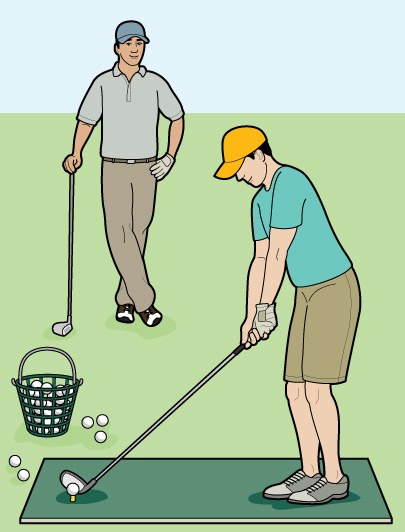 How to Find The Right Pro for You
How to Find The Right Pro for YouWe're suspicious of teaching pros who talk a lot. The best teachers ask — or determine quickly — how you learn. Do you learn by watching someone demonstrate? By "feeling" the motion? By analyzing and understanding it? Practiced teachers know that they may have to explain things to an accountant but simply let a painter watch them do it. A third student may "get it" with an image like Sam Snead's grip advice: Grip the club as you might a little bird. You're the patient; know thyself--and then find a person who speaks your language. Sparingly. Golf Digest's list of Top Teachers is a great place to start. (PGA and LPGA Teachers of the Year, too.) These are the teachers that other teachers would send their friends to. Can't beat that.
Return to the Do Everything in Golf Table of Contents
How to Get The Most Out Of a Lesson
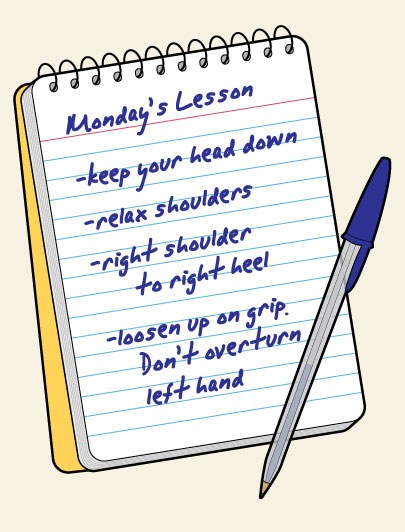 How to Get The Most Out Of a Lesson
How to Get The Most Out Of a LessonThe first few minutes of any lesson should be a discussion between student and teacher on your objectives, how realistic they are, and what is the best way to achieve them based on your talent and commitment to practice. As a student, be prepared to listen and to change. Take clear, simple notes. Write down the main points of the session and make sure they accurately reflect the instructor's message. Don't leave the tee without clarifying confusing points. Follow the prescription and be realistic in your expectations. You should leave with a greater understanding of your swing and a definitive practice plan to improve it. However, changing motor skills often takes time and patience — elements that you must supply to complement your instructor's suggestions.
Return to the Do Everything in Golf Table of Contents
How to Maximize Your Range Time
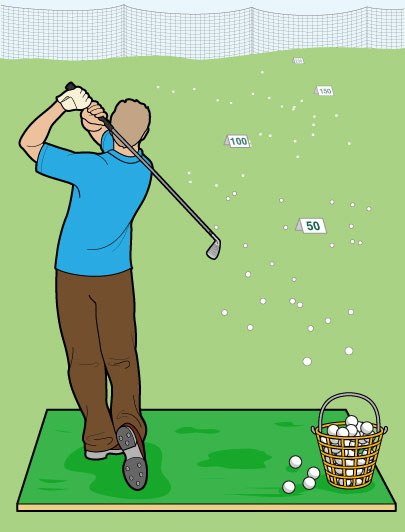 How to Maximize Your Range Time
How to Maximize Your Range TimeIt doesn't matter if you have two hours to spend on the range. If you're not thinking through what you're doing, it's time wasted. Approach your practice sessions with a specific purpose: "I want to practice this move," or, "I want to get comfortable shaping the ball." Once you do that, start with your wedges and work your way through your bag. You won't have time for all your clubs, so just hit your odd numbered irons, and the next time you're on the range, hit your evens. And don't just beat balls into nowhere, hit lots of different shots: high, low, left, right, soft, hard. And, of course, always finish ripping a few drivers.
Return to the Do Everything in Golf Table of Contents
How to Practice vs. Warm Up
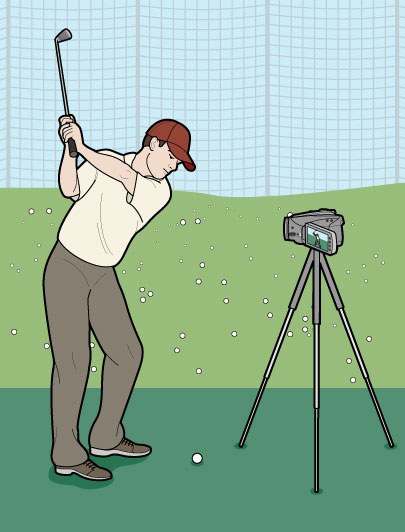 How to Practice vs. Warm Up
How to Practice vs. Warm UpDon't make the mistake of thinking they're the same thing. Practice sessions are about improvement, so do the drills your instructor gave you, focus on your positions and maybe even take some swing video. It's not necessarily about hitting it pure today, it's about preparing to hit it pure the next time you go and play. Warm-up sessions, on the other hand, are about cashing-in all the work you've done in practice, so keep it simple and focus on getting loose and comfortable. Hit lots of wedges and short irons so you can get used to making solid contact. After that, envision the holes you're about to play, and work on the shots you think you'll need to hit.
Return to the Do Everything in Golf Table of Contents
How to Improve in Your Backyard
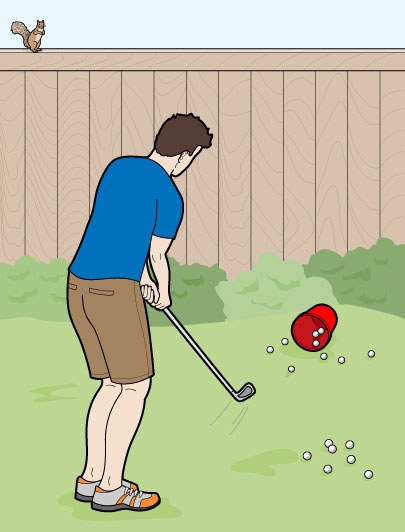 How to Improve in Your Backyard
How to Improve in Your BackyardThe secret to golf may be "in the dirt," but it's findable at home or in the office, too. You don't need to be on the range to grip a club or take a stance, so be methodical and get set up like you're about to hit a shot, then step away and start again. Repeating that process will help improve your fundamentals, but it's not all about the long game. If you have a backyard at your disposal, put a bucket or a large pot on the ground and walk about four paces away, and simply try to chip as many balls into it as possible. It feeds the golf bug, and you'll find the next time you get on the course, you'll be landing more chips in your intended spots.
Return to the Do Everything in Golf Table of Contents
Equipment
How to Buy The Right Clubs For You
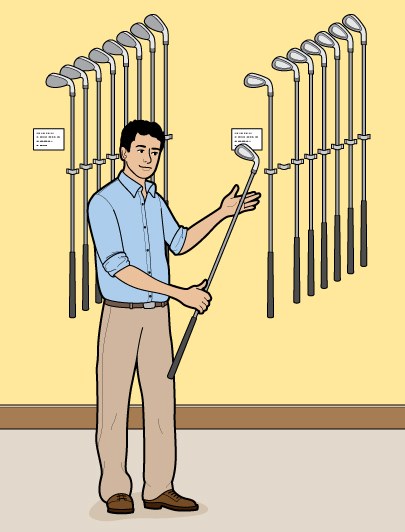 How to Buy The Right Clubs For You
How to Buy The Right Clubs For YouIt may be the question I get most: What are the right clubs for me? I usually respond if you don't go to a professional club fitter (check out our list of the Country's Best Club Fitters, you're wasting your money and time. Sadly, most people don't get fit, so what should you do? Instead of simply choosing the best color, there are some simple general rules to consider when buying clubs, so here goes: Most golfers err by having shafts that are too long or too stiff. A lack of wedges (you need a minimum of three, including pitching wedge, but four is likely better because a fair portion of your shots are insider 100 yards). Your 3-wood is probably too low in loft and, in fact, you probably should have a 4-wood instead as it is easier to get airborne. And if you are having trouble getting the ball in the air with your irons, look at ones with big honkin' soles.
(For our complete rating of the best clubs on the market, go to our Hot List section).
For those who do understand the concept of clubfitting, realize fitting doesn't end with the driver. Irons, wedges, putters and even your golf ball need to be fit to get the most out of your game. Now stop asking me.
— E. Michael Johnson, Senior Equipment Editor, Golf World
Learn more at our Golf Clubs Page
Return to the Do Everything in Golf Table of Contents
How to Pack Your Golf Bag
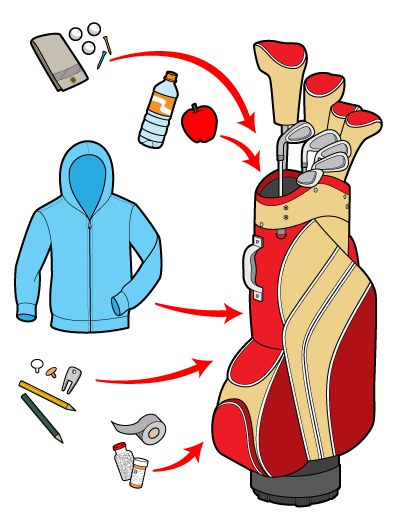 How to Pack Your Golf Bag
How to Pack Your Golf BagThey key to packing your golf bag is simple: keep it as light as you can, without skimping on the essentials. Clubs, balls, tees, and a towel are obvious musts, so once you have those, just take some time to plan for the other stuff you might need. Don't assume the course will have food, so pack fruit and water. Always keep your wet weather gear in your bag, and you never want to be that person marking their ball with a tee, so bring lots of ball markers, pencils and divot repair tools. After that, it's really down to your own needs. You could bring some sports tape to if you have blisters, or if you're struggling with some small injuries (or recovering from a tough night out), pack some aspirin.
Return to the Do Everything in Golf Table of Contents
How to Keep Your Clubs in Good Condition
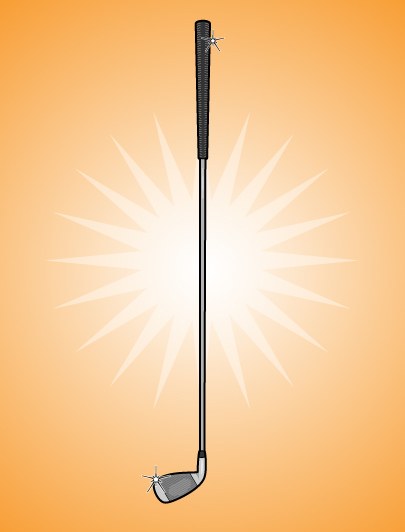 How to Keep Your Clubs in Good Condition
How to Keep Your Clubs in Good ConditionClubs are expensive. We get that. But there are ways to inexpensively maintain your current set so that it feels like you've splurged. Grips usually cost $6 to $10, for example, but you can make old clubs feel fresh without a huge investment. If you're not quite ready to replace them, clean them. Grab a towel, squirt some water and dish washing soap on to it and rub down each grip. Once they dry, your grips will feel tackier and better than they did five minutes prior. (But seriously, if you haven't replaced your grips in more than two seasons, it's time to do so.) Just as the grip is your only connection to any given club, the club face is the only part that connects with the ball. So take a tee and remove the dirt that's trapped within each groove. Instant (and free) performance.
Return to the Do Everything in Golf Table of Contents
How to Ship Your Clubs
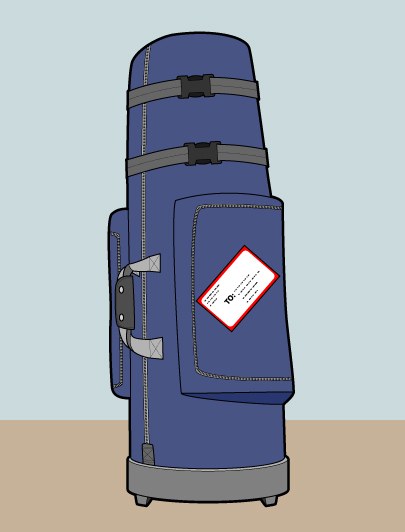 How to Ship Your Clubs How to Ship Your Clubs |
Traveling with golf clubs isn't fun. Luckily, companies like ShipSticks.com have partnered with major mail carriers to offer an affordable alternative. ShipSticks.com allows golfers the option of having their golf bag picked up at their home, their office, their nearest UPS or FedEx Store, or at one of more than 1,500 golf courses. |
Here's
the process:
- Schedule your shipment at ShipSticks.com
- Print your shipping label
- Prepare your golf bag by either packing it in a travel bag or in a box
- Attach the shipping label to the bag.
The courier then picks up the bag and ships it. If you prepare ahead of time, shipping your clubs could cost you less than bringing them with you— fees range from $39 (ground delivery, same coast) to $159 (next-day delivery, cross-coast). It's a no-brainer!
Return to the Do Everything in Golf Table of Contents
Damage Control
How to Handle First Tee Jitters
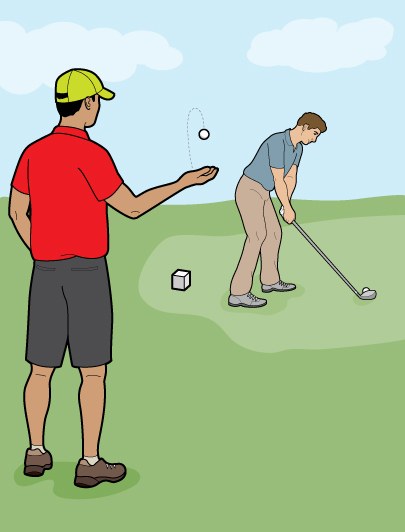 How to Handle First Tee Jitters
How to Handle First Tee JittersThe worst cases of first-tee jitters are no joke, but there are all kinds of useful tricks to handle them. Tossing a ball in the air and catching it, yawning on purpose, stretching, taking deep breaths and making super-slow practice swings are proven devices that can help. But the real secret is tricking yourself into believing you don't care very much. Try to pretend that this terrifying scenario — be it playing in a tournament, with your boss or for a lot of money—is rather a bore. In your heart you know it matters, but you're playing the role of someone who thinks it doesn't. You'll know the technique is working when you slice that first tee ball into the rough and blame it on not concentrating enough.
Return to the Do Everything in Golf Table of Contents
How to Holler Fore
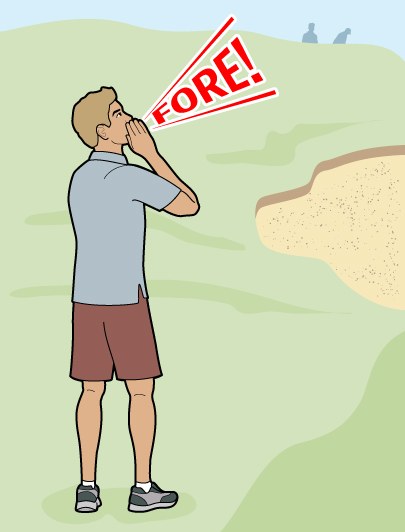 How to Holler Fore
How to Holler ForeScreaming a warning when your ball is headed for another human isn't a courtesy, it's a grave responsibility. It should be a combination of a scream and sharp bark, so that everybody within 250 yards snaps their heads in your direction. The idea is to make the sound travel faster than it really can, since your sound waves are competing with the incredible velocity of the golf ball itself. Cupping your hands will be help. So will more than one voice; everyone in the foursome should yell. It's surprising that people have the presence of mind to think of "Fore!" before actually yelling it. In every other walk of life, we holler, "Look out!" Come to think of it, "Look out!" isn't such a bad idea. The point is to make everyone in eyesight to duck and cover.
Return to the Do Everything in Golf Table of Contents
How to Survive a Nightmare Round
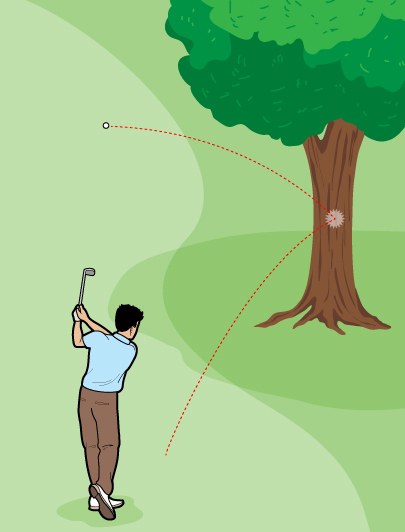 How to Survive a Nightmare Round
How to Survive a Nightmare RoundThere are days when it quickly becomes apparent that messages from your brain aren't reaching your golf clubs. Add to that a spate of unprecedented bad luck, and what you have is a nightmare round. You'll get through this. The key is to treat this dark day with humor, humility and some amount of acceptance. Confront it. Learn from it. Make a few mental notes on how your swing feels and if possible, where your misses are going. Slow down your swing and see if you can find a "safety shot" that makes your foozles at least playable. Shift your attention to things you don't normally think about — he great camaraderie in your foursome, perhaps, or maybe the beauty of the golf course. Whatever you do, don't get angry. And never double the bet on the back nine.
Return to the Do Everything in Golf Table of Contents
How to Not Lose a Ball
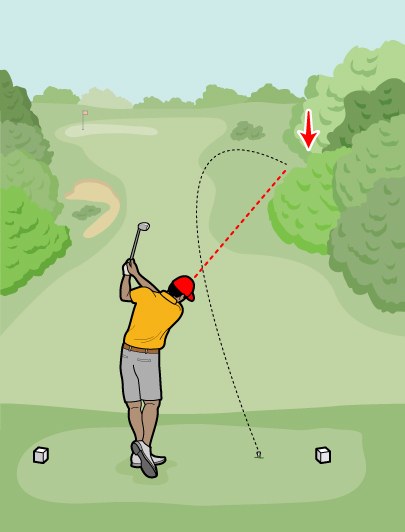 How to Not Lose a Ball
How to Not Lose a BallHitting it straight always helps, but when you hit one astray, the key is to pay attention. Yes, the normal reaction is drop your head in shame, but making yourself watch your bad shot to its conclusion is the only way to know where it actually ends up. Follow the ball's flight into trouble and pick out a mark (perhaps a tree or a bush) to use as a reference point. Remember the angle the ball took when crossing into trouble and then proceed to that spot. Watching your bad shots certainly isn't as fun as striking a pose after striping one down the middle, but when it comes for tracking them down, it will help save you time, money, and strokes.
Return to the Do Everything in Golf Table of Contents
How to Play in Foul Weather
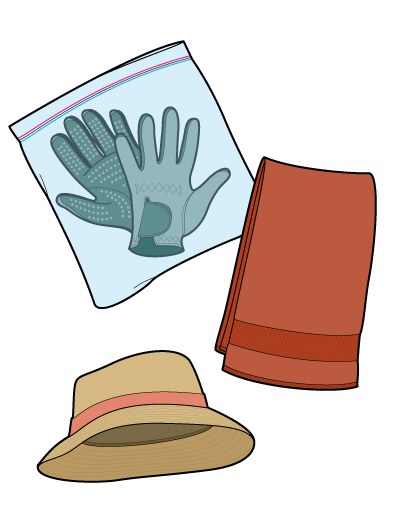 How to Play in Foul Weather
How to Play in Foul WeatherYou've probably heard the basics before — dress in layers, get a good umbrella, invest in a quality rain suit, etc. But performance is even more important. Let's face it, if you play well, the bad weather won't bother you. A few tricks: Keep one towel dry. If you can't grip the club, all hope is lost. If rain gloves aren't your thing, you'll need a good towel to dry your grips. Keep the towel under the spokes of your umbrella. Keep extra gloves — stored in a zip-lock plastic bag — in your bag. And handle stuff between shots with your non-gloved hand. Get a waterproof bucket hat. A dry head means something on the performance end. A baseball-style cap, with water dripping off the bill, is an annoyance you don't need.
Return to the Do Everything in Golf Table of Contents
Fitness
* Note - Learn more on our Golf Fitness Page and share your tips on our Golf Fitness Tips Page
How to Stretch
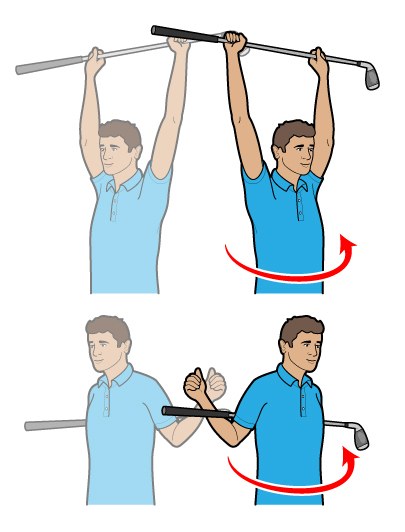 How to Stretch
How to StretchBefore hitting, concentrate on loosening up two injury-prone areas: Your shoulder joints and lower back. Holding two clubs in your left hand with your arm extended, emulate a slow-turning windmill. Do 10 slow revolutions in each direction. Switch arms. Repeat. Now, the lower back. Holding the club horizontally with both hands above your head, rotate your torso in broad circles for a full minute. Then do what Jack Nicklaus does: Hold a club behind your back, locking it in the crooks of your arms, and twist back and forth — gently, until you feel loose. The whole process takes about five minutes. You're now ready to make your first swings of the day.
Learn more about stretching on our Golf Fitness Page under Flexibility
Return to the Do Everything in Golf Table of Contents
How to Get Exercise When Driving a Golf Cart
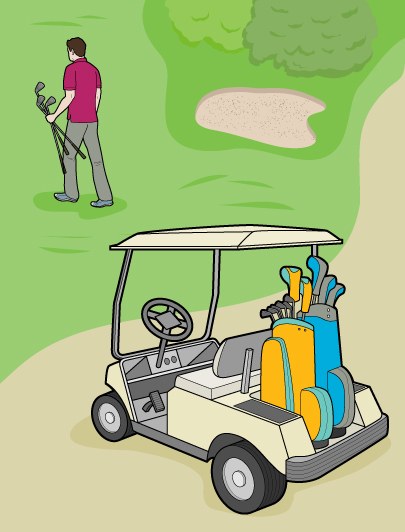 How to Get Exercise When Driving a Golf Cart
How to Get Exercise When Driving a Golf CartBelieve it or not, you get a fair amount exercise taking a cart, even if you don't make any extra effort to add steps. With a bit of awareness you can transform 18-with-a-cart into a lot more exercise: Walk every other hole and suggest your cart mate do the same. Off the tee, drive to his ball and then grab a couple of clubs and walk to yours. As you approach the green, let him take the cart, as you grab your wedges and putter and walk the rest of the way. When searching for balls, immediately get out of the cart and look on foot — it's more efficient anyway. Wear a fitness band to keep track of your steps and establish a "par" you want to reach each time you play. Or, take a caddie and let him drive the cart. Seriously!
Return to the Do Everything in Golf Table of Contents
How to Eat and Drink During a Round
 How to Eat and Drink During a Round
How to Eat and Drink During a RoundIf you really want to play better, consider what you're putting in your tank. Drink roughly 16 ounces of water before you play, and repeat at least one more time during the round, though twice is better. And that means water. Not sports drinks, fruit juice, soda or beer. When you're hungry, the best foods are non-processed and consist of lean protein, unsaturated fats and fiber. Eggs and a piece of whole-wheat (not multigrain) toast will do wonders. So will an apple and some raw almonds. It's lunchtime? Go with grilled chicken and a spinach-leaf salad. Need something quick, easy and practical? Bananas and natural beef jerky are superfoods and store in a golf bag very conveniently. What shouldn't you eat? Granola bars, most energy bars, crackers, chips, pretzels, candy bars, hot dogs...Should we keep going?
Return to the Do Everything in Golf Table of Contents
How to Play in Heat and Humidity
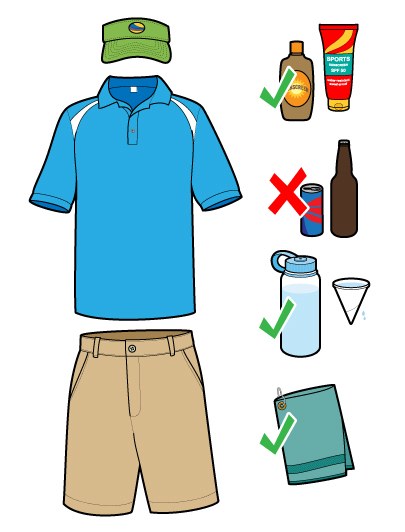 How to Play in Heat and Humidity
How to Play in Heat and HumidityChoose clothing that's light-colored and cotton, since cotton breathes and dark colors tend to attract the hot rays of the sun. Pace yourself when walking and spend as much time as possible in the shade. Perspiring is your body's natural defense against overheating, so it's vitally important that you drink plenty of liquids to avoid dehydration. Drink plenty of fluids before your round, and then take lots of little drinks during the round. Gripping the clubs becomes difficult when you perspire, so make sure you have plenty of dry gloves and towels. Ironically, it's also a good idea to wet a towel with cold water and use it to wet your hands as you walk down the fairway.
Return to the Do Everything in Golf Table of Contents
Hitting The Road
How to Dress for The Course
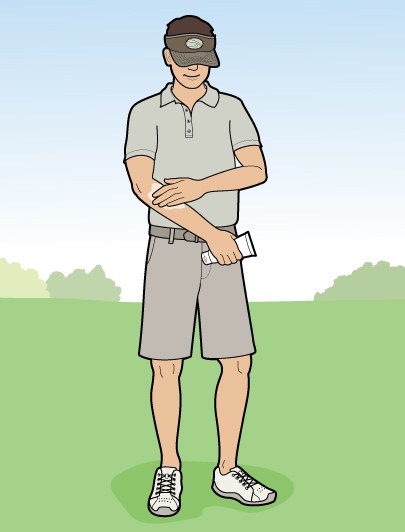 How to Dress for The Course
How to Dress for The CourseThe first ground rule is to keep it simple. It's not necessary to go out and purchase "golf clothing". Find some sportswear that fits and is comfortable and you'll be off to a good start. Your can purchase a pair of hybrid (no cleats) golf shoes that will work both on and off course. If you are going to wear shorts, make sure they are long enough to get close to your knee, and purchase calf-length socks. Should you be on the big or small side, keep your color selections conservative and keep everything in the same tone. Lastly, remember that you will be outside, so make sure to wear sunscreen.
— Marty Hackel, Golf Digest Fashion Director
Return to the Do Everything in Golf Table of Contents
How to Pack For a Golf Trip
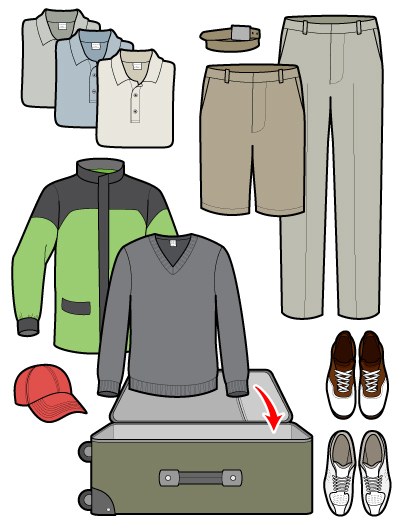 How to Pack For a Golf Trip
How to Pack For a Golf TripHave a game plan. Women tend to pack outfits, while men pack shirts THEN pants THEN shorts. This can lead to over-packing. To make it easy, you should choose your favorite color golf shirt and build your wardrobe around it. Only pack similar colors and you will be able to mix and match. If you are packing blue trousers pack blue shorts and plan to coordinate the rest of your outfit accordingly. Pack lightweight layers (sweater and wind breaker) as it's easier to add and subtract on course than deal with a heavy outer-garment. And for trips longer than three days I strongly recommend two pair of golf shoes for insurance.
Lastly, unless you are going to Scottsdale in July, pack your rainwear. Better to have it and not need it than the other way around.
— Marty Hackel, Golf Digest Fashion Director
Return to the Do Everything in Golf Table of Contents
How to Tip
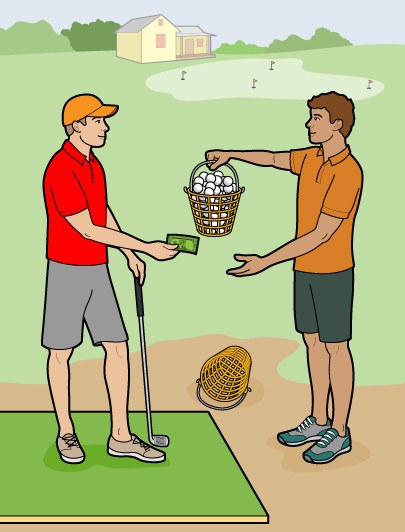 How to Tip
How to TipKnowing who to tip and when to tip can be a mystery to many golfers, but don't let it stress you out. For starters, there's no harm in asking. If you have a caddie and aren't sure how much to tip him, the caddie master will be happy to tell you. As for everyone else — the guy in the locker room, the guy who pulls the clubs out of your trunk, the guy who brings you balls at the range—it's the gesture of tipping that is actually more important than the amount. True, tipping is a way to supplement the income of people who rely on more than just an hourly wage. But you don't need to stuff someone's pockets full of twenties to make them feel appreciated. A buck or two is a simple way of acknowledging someone's efforts.
Return to the Do Everything in Golf Table of Contents
How to Pick a Buddies Trip Destination
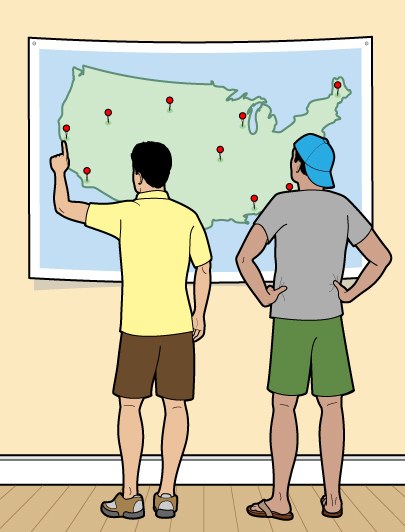 How to Pick a Buddies Trip Destination
How to Pick a Buddies Trip DestinationThere's no better way to bond with your pals than a buddies golf trip. As you think about where to go, keep in mind that each buddies destination has its own personality. Myrtle Beach and Alabama's Robert Trent Jones Golf Trail are great if you want a ton of golf at good prices. But if you're imagining a more a luxurious getaway, Sea Island, the American Club, or Pebble Beach may be more your speed. Oregon's Bandon Dunes is fantastic for avid players, but if you're expecting wild-and-crazy nightlife, you'll be sorely disappointed. [Cue crickets sound effect.] Start by spending some time on our Buddies Golf page, which has links to articles on these and many other destinations, advice from expert trip-planners, and more. Once you've picked a few destinations that seem promising, visit our Course Finder and spend some time comparing the courses in each region.
Return to the Do Everything in Golf Table of Contents
How to Take a Golf Photo
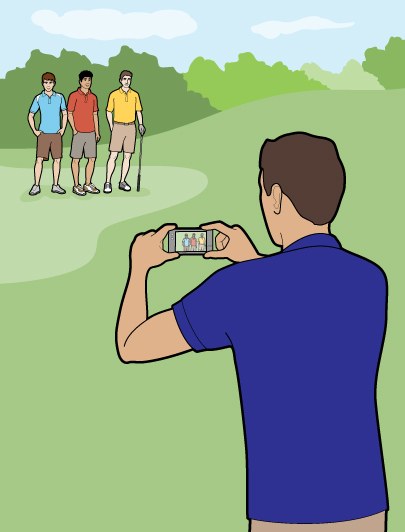 How to Take a Golf Photo
How to Take a Golf PhotoMaybe the most important thing to think about with golf photos is WHEN you're shooting, since images shot in the harsh light of midday tend to disappoint. Instead, try shooting first thing in the morning, or in that golden hour before sunset, when even your neighborhood muny can look like coffee table material. Next, think about what you're shooting. Avoid busy backgrounds. And don't feel compelled to center things in the middle of the frame. Off centering a subject has a way of making things more interesting. And always expose for the grass, not for the sky.
— Christian Iooss, Director of Photography
Return to the Do Everything in Golf Table of Contents
Getting Serious
How to Join a Club
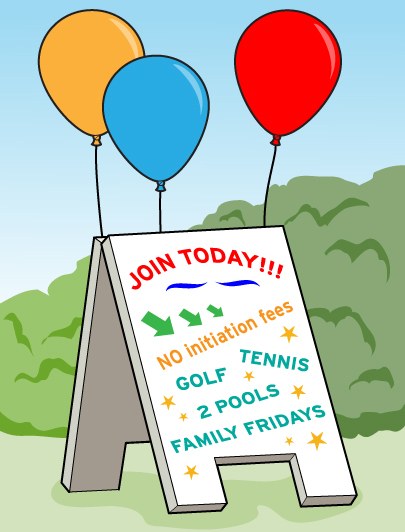 How to Join a Club
How to Join a ClubThe important thing is getting to know as many of the club's members and its course before making a decision (budget is also important, but these days many clubs are hurting for members and you shouldn't have trouble finding a good deal). Visiting the club is key — with your family preferably — and playing the golf course more than once or twice. As with marriage and home buying, you're in this for the long haul, so get a good feel for the place: Is this an old boy's club? Or is it centered around the family? That sort of thing. Ask yourself: Can I play this course every day? With these folks? If your heart says yes, ask a member to get started with the formal process — which is a real commitment on the member's part — and you'll thank yourself for the due diligence.
Return to the Do Everything in Golf Table of Contents
How to Pick a Partner For a Team Event
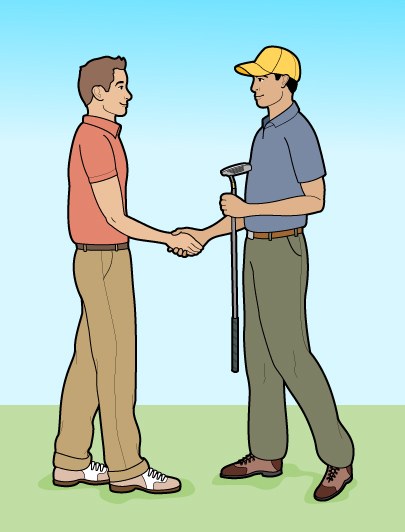 How to Pick a Partner For a Team Event
How to Pick a Partner For a Team EventHandicap guys suggest you match Steady Eddie with Wild Willy. You want to be in every hole (close to net par) and Eddie puts you there. If you're Eddie, you should be looking for Willy, who will give you a chance to score net birdies and eagles. A good way to determine who's who is to compare "anti-handicaps" — a number based on a golfer's 10 worst scores out of the last 20 instead of the 10 best, which is how handicaps are calculated. Eddie's anti-handicap will be close to his real handicap. Wild Willy's will be much, much higher. Above all, choose someone you like, preferably a good putter, someone who plays at about the same pace as you, and someone who is forgiving — of you and himself.
Return to the Do Everything in Golf Table of Contents
How to Play a Nassau
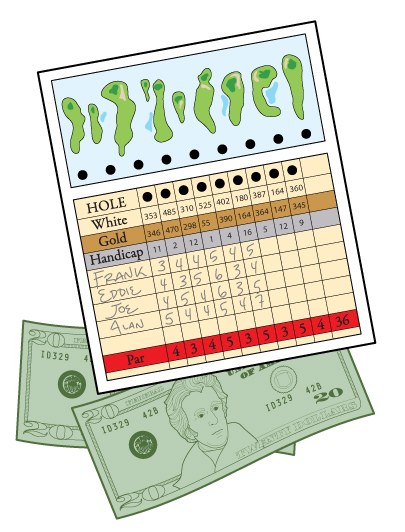 How to Play a Nassau
How to Play a NassauPerhaps the most popular golf gambling game is a nassau (lowercase n, though it gets its name from Nassau Country Club on Long Island, N.Y., where it originated). It's a match-play competition between individuals or teams that begins with three wagers: one for the front nine, one for the back and one for the full 18 holes. The amount of each wager is determined before the game begins and each side competes in two nine-hole matches and one 18-hole match. There are many variations to the game, including one where you can add more bets to the mix for any number of reasons. In one scenario, a "press" bet is added if a team goes 2 down in any of the existing wagers. In another scenario, a team that is trailing can start a new bet at any point.
Learn more about the nassau and our other game suggestions.
Return to the Do Everything in Golf Table of Contents
How to Get The Most From a Caddie
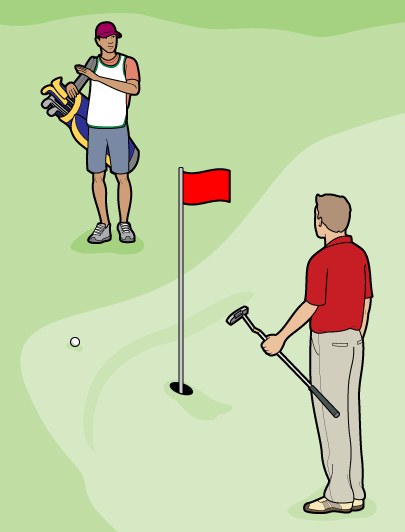 How to Get The Most From a Caddie
How to Get The Most From a CaddieYou shouldn't expect the same from a beginning youngster that you might from a tour caddie, but they should have a number of things in common: A caddie should be prompt, dependable, aware, have knowledge of the rules and know their yardages. None of that takes any special training. A good local caddie will also be able to read greens and alert you to any unique local conditions, such as swirling winds, hidden bunkers, etc. It's not fair to expect a caddie to be able to "club" you the first time out. Nobody is that good. Nor is it fair to be abusive to a caddie in any way. Mike Carrick, former caddie for Tom Kite, sums it up pretty well: "Treat your caddie as you would your son."
Return to the Do Everything in Golf Table of Contents
How to Get a Handicap
 How to Get a Handicap
How to Get a HandicapA handicap is an invaluable asset to a golfer because it enables you to monitor your progress, and compete with players of varying ability. For private club members or public golfers affiliated with a specific course, you can often sign up for a USGA handicap through your course. Don't play any one place? There are golf clubs without real estate that also allow you to maintain a handicap. Better yet is to sign up for the new Golf Digest Handicap. It's free, simple to use, and to get started, you don't have to do anything more than click here for details.
Check out our Index & Handicap Page to learn more.
You can also get yourself an Official USGA Handicap Index by clicking the MyScoreCard Logo below.
Return to the Do Everything in Golf Table of Contents
How to Use a Handicap in a Match
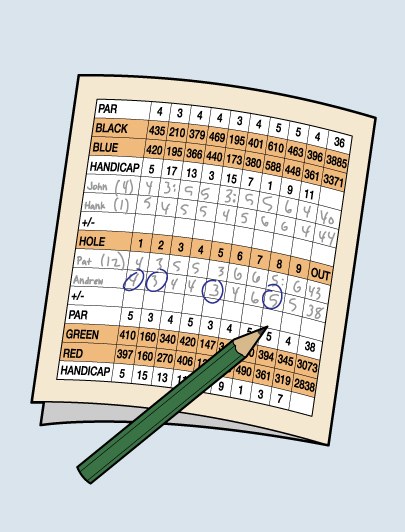 How to Use a Handicap in a Match
How to Use a Handicap in a MatchOnce you have a handicap, you need to know how to use it in a match against another golfer. If you both have the same course handicap, the match is played even. If you had a higher course handicap than your opponent, you would get to subtract a handicap stroke on select holes. For example: If you had a course handicap of 15, and your opponent was a 13, subtract one stroke from your score on the two holes rated No. 1 and No. 2 in difficulty. Look at the scorecard and you'll notice they have been ranked from 1 to 18 (don't confuse this with the hole number itself).
Check out our Index & Handicap Page to learn more.
Return to the Do Everything in Golf Table of Contents
So now that you now know how to "Do Everything in Golf" it's time to get out and put your new found knowledge to use. Use the links below to book your next round(s) and get out there and play.
"Hit 'em Straight and Not Too Often"
Options for Booking Your Next Tee Time
?? Your Own Website ??
Is there a topic or a hobby for which you have a strong passion?
Have you ever considered turning that passion into a passive income stream?
Have you ever considered creating a web site like this one?
I researched long and hard for the best resources available on the web to assist me in making The-Golf-Experience.com a reality and I found none better than Solo Build It with whom to partner.
Above and beyond the comprehensive program they provide to assist you on your journey is the incredible level of customer service you'll get along the way. The world would be a better place if every company out there modeled the quality and level of their customer service after what Solo Build It seems to provide with such ease.
Watch the video below to see if your interest in creating your own web site gets a spark.
You ready?
Now click the "Solo Build It!" link below to begin your own journey.
Good luck and have some fun.
© Copyright The-Golf-Experience.com
"When Health is absent, wisdom cannot reveal itself, art cannot become manifest, strength cannot be exerted, wealth is useless, and reason is powerless."
Herophilos 335-280 B.C.
All athletes require the performance components of: strength, power, endurance, flexibility, coordination, balance, good posture, and mental conditioning to perform at their best.
Stay Healthy - Play your Best
~ ~ ~
Visit our Fitness Page to learn more!
Start investing with Acorns today and they'll add $5 to to your account to help you get started - You won't retire on their contribution ... but $5 is still $5
Visit our page on Golf Balls to learn ALL you need to know to determine which ball is best suited to your unique swing speed and style of play.
Then visit Lost Golf Balls below to buy used golf balls in the quality suited to your game and the quantity required to keep your bag full.
Find Inexpensive Gas with Gas Buddy
If you really want to save at the pump though - Get yourself a Pay With Gas Buddy Card.
Join for free to save $.05 per gallon or get a Plus or Premuim Membership to save $.20 per gallon.
Points are awarded for each score on every hole. You can use any modification for points awarded (or subtracted) on every hole, but the R&A and the USGA award points as follows:
If you appreciate exceptional customer service and personal attention given to filling your golf needs The-Golf-Experience.com highly recommends shopping with
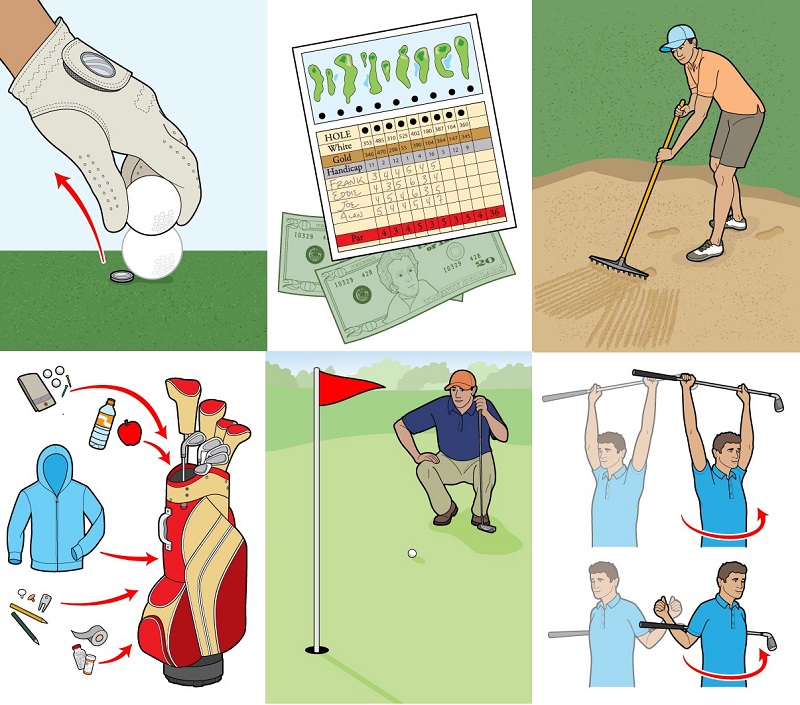










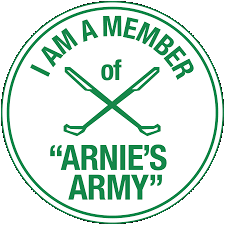



















New! Comments
Join the conversation by sharing your comments and opinions about the content on this topic in the box below.